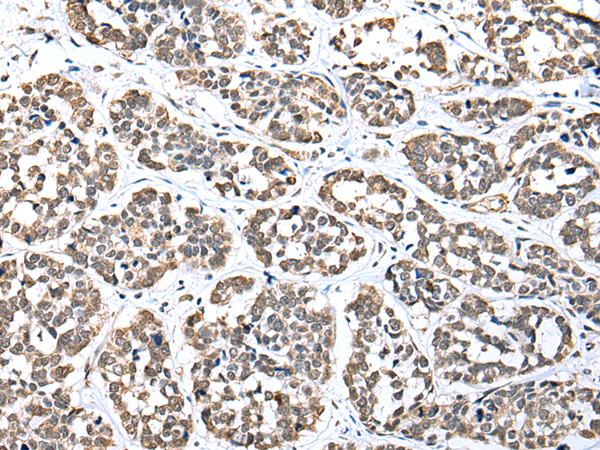

| WB | 咨询技术 | Human,Mouse,Rat |
| IF | 咨询技术 | Human,Mouse,Rat |
| IHC | 1/25-1/100 | Human,Mouse,Rat |
| ICC | 技术咨询 | Human,Mouse,Rat |
| FCM | 咨询技术 | Human,Mouse,Rat |
| Elisa | 1/5000-1/10000 | Human,Mouse,Rat |
| Aliases | p37 |
| Host/Isotype | Rabbit IgG |
| Antibody Type | Primary antibody |
| Storage | Store at 4°C short term. Aliquot and store at -20°C long term. Avoid freeze/thaw cycles. |
| Species Reactivity | Human, Mouse, Rat |
| Immunogen | Fusion protein of human UBXN2B |
| Formulation | Purified antibody in PBS with 0.05% sodium azide and 50% glycerol. |
+ +
以下是关于UBXN2B抗体的3篇文献示例(注:文献信息可能需结合实际数据库检索验证):
1. **文献名称**: *UBXN2B interacts with the SLC43A3Tas1R1/3 receptor complex and inhibits umami taste signaling*
**作者**: Li X, et al.
**摘要**: 研究揭示了UBXN2B在味觉信号通路中的作用,通过免疫共沉淀(使用UBXN2B抗体)证实其与Tas1R1/3受体的相互作用,并发现其负调控鲜味感知。
2. **文献名称**: *UBXD proteins: A family of proteins with diverse functions in cancer*
**作者**: Wang Y, et al.
**摘要**: 综述了UBXD蛋白家族(含UBXN2B)在癌症中的调控机制,提及UBXN2B抗体在肿瘤组织中的表达分析,提示其可能作为预后标志物。
3. **文献名称**: *Proteomic analysis of the human ubiquitin regulatory X (UBX) domain-containing protein family*
**作者**: Suzuki R, et al.
**摘要**: 通过质谱和Western blot(使用特异性UBXN2B抗体)系统分析了UBX家族成员的亚细胞定位及相互作用网络,发现UBXN2B在内质网应激中的作用。
**注**:以上文献为示例性质,实际文献需通过PubMed或Google Scholar以关键词“UBXN2B antibody”或“UBXN2B function”检索。若需具体文献,建议补充研究背景(如疾病或通路方向)以便精准筛选。
The UBXN2B antibody targets the UBXN2B protein, a member of the UBX domain-containing protein family implicated in regulating cellular processes such as ubiquitination, apoptosis, and immune signaling. UBXN2B (UBX Domain Protein 2B), also known as UBXD6 or FAF2. contains a ubiquitin regulatory X (UBX) domain and a coiled-coil region, enabling interactions with proteins like valosin-containing protein (VCP/p97) and components of the ubiquitin-proteasome system. It is involved in modulating the NLRP3 inflammasome, ER-associated degradation (ERAD), and lipid metabolism.
UBXN2B antibodies are essential tools for studying its role in diseases linked to dysregulated inflammation (e.g., neurodegenerative disorders, cancer) or metabolic dysfunction. Researchers use these antibodies in techniques like Western blotting, immunofluorescence, and immunoprecipitation to assess UBXN2B expression, localization, and interaction partners. Studies suggest UBXN2B acts as a negative regulator of NLRP3 activation, highlighting its therapeutic potential. Antibody specificity is validated across species (human, mouse), with applications in both basic research and preclinical models. Understanding UBXN2B's function via antibody-based assays contributes to elucidating its pathophysiological relevance and identifying novel drug targets.
×